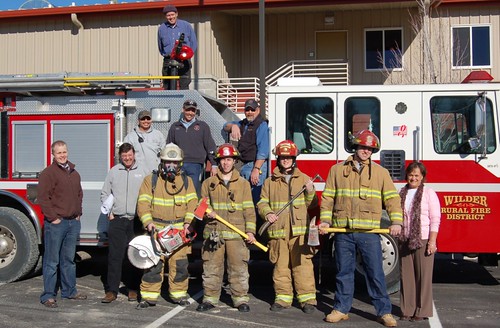
I’m at the new Fire Station in Wilder, Idaho, where Engine 821 can now be stored indoors, protected from the elements, thanks to the community approving the financing of the station through USDA Rural Development’s Community Facility Loan and Grant Program, with funding provided to Rural Development in the American Recovery and Reinvestment Act (Recovery Act) of 2009.
Guess what these volunteer fire fighters are doing today? Yep, volunteering their time! But today doesn’t have anything to do with providing emergency services - today the volunteers were actually assisting us, Idaho Rural Development.
Centennial Job Corps Center (U.S. Forest Service) dubbed February 2nd as “Groundhog Job Shadow Day” and we were given the opportunity to demonstrate the various career fields employed here at Rural Development to four young adults currently developing carpentry and electrical skills through the training offered at the center. Rather than have the students look over blue prints and sit in on a loan committee, we opted to show the students the results of our careers and why it matters to rural Idahoans that we work hard every for them. We made a couple stops on our tour of completed projects, but the most significant to John, Lacy, Chris, and Corey was the visit with the volunteer fire fighters at the new fire station.
The Wilder Fire Department is an all-volunteer fire department and like the other volunteer fire fighters I’ve met, Wilder’s volunteers went way beyond and made this truly an A+ day for these students. Instead of just one fire fighter meeting us, there were four, one per student. We had expected 20 minutes of their time and left nearly two hours later. Doug, the chief, along with Craig, De, and Frank (Frank has been a Wilder volunteer fire fighter longer than these students have been alive) engaged the students in a discussion of certification processes and differences in hiring practices between the various fire districts, followed by students donning the protective gear while the crew carefully explained the different functions of the equipment.
Directing the level of assets responding to a fire has additional considerations in rural areas. First of all, there isn’t a fire hydrant on the corner to hook up to access water so additional resources may be requested to ensure an adequate water supply on site. Rural fire districts cover vast geographical areas so travel time is a significant factor to respond to emergencies within the district, but requires the decision point to be even sooner when assistance is requested from a neighboring district. And of course, with volunteer departments, the crew needs time to get to the station. This sometimes results in assets being called but never employed, but this is all the more reason to ensure these volunteers have adequate resources and training so they continue to volunteer as they face all the other hassles of today’s busy lifestyles . . . and having Engine 831 parked in a protected bay is a nice start.

